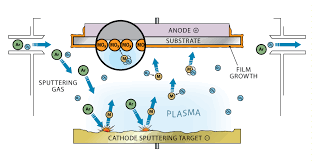
Sputtering Process in Nanotechnology: A Key Technique for Material Deposition
The sputtering process is a cornerstone of nanotechnology, enabling the deposition of thin films with exceptional precision and control. Used in industries ranging from electronics to renewable energy, sputtering is a versatile physical vapor deposition (PVD) technique that allows for the creation of nanostructured materials with tailored properties. Its ability to manipulate material composition and structure at the nanoscale has made it indispensable in advancing modern technologies.
What is Sputtering?
Sputtering is a process where atoms are ejected from a target material due to bombardment by high-energy ions, typically generated in a plasma. These ejected atoms then deposit onto a substrate, forming a thin film. This method is highly effective for creating uniform coatings and nanostructures.
Types of Sputtering Techniques
- DC Sputtering:
- Direct current sputtering is used for conductive materials and provides a simple, cost-effective approach for thin film deposition.
- RF Sputtering:
- Radio frequency sputtering is ideal for insulating materials and offers better control over deposition rates and film properties.
- Magnetron Sputtering:
- Employs magnetic fields to confine plasma, increasing efficiency and deposition rates while reducing substrate heating.
- Reactive Sputtering:
- A reactive gas, such as oxygen or nitrogen, is introduced to form compound films like oxides or nitrides during deposition.
- High-Pressure Sputtering:
- Used for creating highly textured or porous thin films suitable for specialized applications.
Applications of Sputtering in Nanotechnology
- Electronics:
- Sputtered thin films are crucial in manufacturing semiconductors, microchips, and display technologies such as OLEDs and LCDs.
- Energy Storage:
- Thin film batteries and supercapacitors benefit from sputtered electrode materials that enhance performance and longevity.
- Solar Cells:
- Sputtering is used to deposit transparent conductive oxides (TCOs) and other layers to improve the efficiency of photovoltaic cells.
- Biomedical Devices:
- Coatings produced by sputtering improve biocompatibility, wear resistance, and functionality in implants and sensors.
- Optical Coatings:
- Anti-reflective, protective, and decorative coatings on lenses, mirrors, and optical devices are commonly made using sputtering.
- Magnetic Storage Media:
- Sputtered films are used in the production of hard drives and other data storage technologies.
Advantages of Sputtering
- Precision and Uniformity:
- Enables the deposition of films with precise thickness and uniform composition.
- Material Versatility:
- Suitable for a wide range of materials, including metals, ceramics, and polymers.
- Scalability:
- Applicable to both small-scale research and large-scale industrial production.
- Tailored Properties:
- Allows for customization of film properties, such as hardness, conductivity, and optical transparency.
- Low Contamination:
- Operates in vacuum or controlled environments, minimizing impurities in the deposited films.
Challenges in Sputtering
- High Equipment Costs:
- Sputtering systems require significant initial investment, limiting accessibility for smaller enterprises.
- Slow Deposition Rates:
- Compared to other deposition methods, sputtering can be slower, impacting production throughput.
- Material Waste:
- Not all sputtered atoms reach the substrate, resulting in some material loss.
- Complex Process Control:
- Achieving consistent film quality requires precise control over process parameters.
Future Prospects
- Advanced Materials:
- Development of new target materials to create films with novel properties and functionalities.
- Nanostructured Films:
- Expanding applications in creating textured or multilayered films for advanced electronics and photonics.
- Energy Applications:
- Enhancing the role of sputtering in renewable energy technologies, such as next-generation solar cells and fuel cells.
- Automation and AI Integration:
- Implementing automated systems and AI for real-time process monitoring and optimization.
Conclusion
The sputtering process is an essential technique in nanotechnology, offering unmatched versatility and precision in material deposition. Its applications span numerous industries, and ongoing advancements in sputtering technology promise to drive innovation in energy, healthcare, electronics, and beyond. As researchers and engineers continue to refine this process, sputtering will remain at the forefront of material science and nanotechnology.
